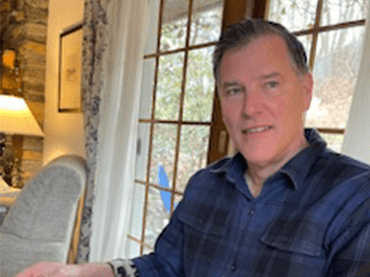Bob Keeley, 57, normally goes “hard core” at everything he does. But in June 2023, he was taking an uncharacteristically easy ride down the mountain bike trail at Snowshoe Resort in West Virginia when he suddenly flipped his bike. He landed in a sitting position but instantly knew something was wrong.
“I had sharp pain in my right shoulder, so I thought I tore my rotator cuff,” he says. “I also had tingling in my right arm and foot.”
At a nearby community hospital — and later confirmed at a trauma center in Virginia — x-rays showed Bob had fractured his spine at the base of his neck. Although doctors determined he didn’t need surgery, they advised him to rest and wear a neck brace for three months while it healed.
"We felt that UPMC and Dr. Agarwal met our criteria for a quality program with a great reputation." – Bob
Schedule an Appointment or Ask a Question
The Challenge: Continuing Pain, Instability
Bob and his wife, who split their time between West Virginia and a beach home in Milton, Del., returned to their cabin in Snowshoe. There, he followed medical advice to continue wearing a neck brace, take it easy, and use prescription painkillers. But that didn’t sit well with the former bodybuilder and semipro road cyclist who normally works out daily and enjoys sailing, skiing, and hiking.
“I’m a very active person and I go hard at everything I do,” says Bob. “I’m also very proactive. It didn’t make sense to me to just sit there hoping it would get better.”
He wasn’t just frustrated. Bob also was concerned about the continued tingling in his extremities, plus constant neck pain and instability. “My neck was like a bobblehead without the brace,” he says.
The Path to UPMC
Unwilling to wait it out, Bob decided to get a second opinion from another neurosurgeon. Through a longtime family friend, he learned about Nitin Agarwal, MD, a UPMC Neurological Institute neurosurgeon and spine specialist.
Dr. Agarwal is director of the UPMC Department of Neurological Surgery minimally invasive spine and robotics surgery program. He also is associate program director of the neurological surgery residency program at the University of Pittsburgh School of Medicine.
“We felt that UPMC and Dr. Agarwal met our criteria for a quality program with a great reputation,” says Bob. “So, we went to Pittsburgh.”
After reviewing his case, Dr. Agarwal agreed that the Virginia doctor was right to suggest wearing a neck brace until the fracture healed. But there was no guarantee the nerve pain would resolve. Dr. Agarwal suggested another option — an anterior cervical discectomy and fusion (ACDF). To relieve pressure on the nerve and stabilize the spine, a combined spinal decompression and spinal fusion procedure would be done through an incision in the front of his neck.
“We discussed the pros and cons, then I thought about it overnight,” says Bob. “The next morning, I called back and said, “Let’s do it!’”
The Solution
In late June, Bob was admitted to UPMC Presbyterian for presurgery testing and imaging, including a video of his throat. The next day, he went into the operating room with a multidisciplinary team of surgeons at his side.
The surgery began with Carl Snyderman, MD, a UPMC otolaryngologist and specialist in head-and-neck and cranial base surgeries, carefully moving Bob’s esophagus aside to provide access to the spine. This anterior, or frontal, approach was needed due to the highly sensitive nature of the fracture, which impinged on vital structures.
Dr. Agarwal then began the fracture repair through an incision in the front of his neck with a second attending neurosurgeon, Kojo Hamilton, MD, director, UPMC Neurosurgical Spine Services.
During the procedure, Dr. Agarwal and Dr. Hamilton meticulously removed the damaged disc between the C6 and C7 vertebrae. They then inserted a graft into the space and fused the vertebrae in place with metal plates and screws.
“It was surgical harmony,” says Dr. Agarwal. “This tandem effort is the culmination of over a decade of our team working together to achieve the best possible outcomes for patients like Bob. It synchronized our years of multidisciplinary experience and surgical expertise into a seamless operation.”
The Results
Bob returned to his hospital room after surgery and was soon up and walking.
“The pain was gone. I could move my head and I didn’t need a neck brace,” he says. “You wouldn’t even know I had surgery.”
He was discharged the next day and traveled back to West Virginia to recuperate. After six weeks, Bob began doing simple therapeutic exercises. He slowly eased into doing yoga and hiking. Six months later, he was back on the slopes at Snowshoe doing “easy” skiing.
“I’m taking it slow. I’m not risking anything,” says Bob. “Why be stupid?”
Although he sold his mountain bike, Bob looks forward to taking up another sport he can “take to the max.”
In the meantime, Bob says he has no regrets about having the surgery.
“Everyone at UPMC was great. And my surgeons were rock stars,” he says. “It was the right thing for me. I can’t imagine where I’d be or what I’d be able to do without the surgery and their expertise.”
Our patient stories profile a number of patients who have had minimally invasive brain surgery at UPMC. Although everyone’s care experience is unique, we hope that sharing these stories will help other prospective patients and their families better understand these procedures and their potential benefits.
Bob's treatment and results may not be representative of all similar cases.

















